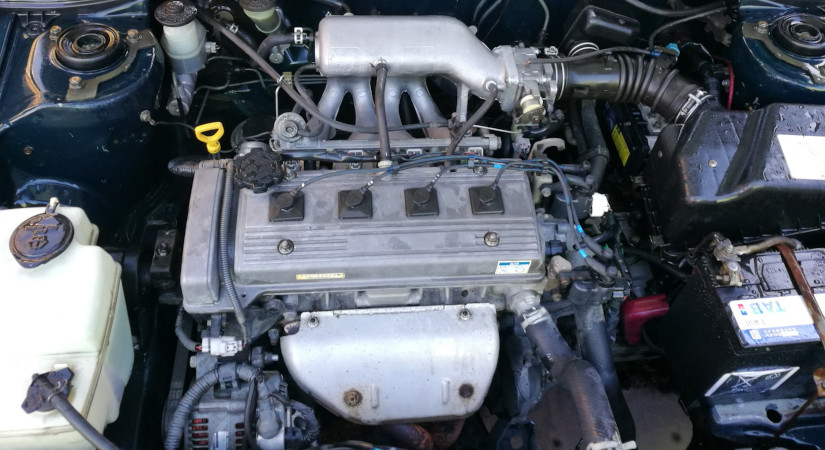The 7A-FE engine was produced from 1993 to 2002. The first generation built for Canada had 115 hp at 5600 rpm and 149 Nm at 2800 rpm. From 1995 to 1997, a special version for the United States was produced, the power of which was 105 hp at 5200 rpm and 159 Nm at 2800 rpm. Indonesian and Russian versions of the engine are the most powerful.
The A family also includes engines: 8A‑FE, 5A‑FE, 5A‑FHE, 4A‑FE, 4A‑FHE, 4A‑GE, 4A‑GZE, 7A‑FE.
The largest power unit of the A series appeared later than everyone else and was no different from its injection counterparts: a cast-iron block and an aluminum cylinder head with two camshafts for 16 valves, a timing belt drive rotates the intake camshaft, and the exhaust shaft is connected to it through a gear. Hydraulic lifters are also not provided.
In addition to the regular version of the engine, an economical Lean Burn modification was common, which can be easily distinguished by the nozzles that are built into the cylinder head, and not into the intake manifold.
The engine was installed on:
- Toyota Avensis 1 (T220) in 1997 – 2001;
- Toyota Caldina 1 (T190) in 1996 – 1997; Caldina 2 (T210) in 1997 – 2001;
- Toyota Carina 6 (T190) in 1994 – 1996; Carina 7 (T210) in 1996 – 2001;
- Toyota Celica 6 (T200) in 1993 – 1999;
- Toyota Corolla 7 (E100) in 1993 – 1997; Corolla 8 (E110) in 1997 – 2002;
- Toyota Corolla Spacio 1 (E110) in 1997 – 2001;
- Toyota Corona 10 (T190) in 1994 – 1996; Corona 11 (T210) in 1996 – 2001;
- Toyota Sprinter E110 in 1995 – 2001.
Specifications
| Production years | 1993-2002 |
| Displacement, cc | 1762 |
| Fuel system | injector |
| Power output, hp | 105/5200 110/5600 115/5600 120/6000 |
| Torque output, Nm | 159/2800 156/2800 149/2800 157/4400 |
| Cylinder block | cast iron R4 |
| Block head | aluminum 16v |
| Cylinder bore, mm | 81 |
| Piston stroke, mm | 85.5 |
| Compression ratio | 9.5 |
| Manufacturer | Kamigo Plant Shimoyama Plant Deeside Engine Plant North Plant Tianjin FAW Plant No. 1 |
| Hydraulic lifters | no |
| Timing drive | belt |
| Phase regulator | no |
| Turbocharging | no |
| Recommended engine oil | 5W-30 / 10W-30 / 15W-40 / 20W-50 |
| Engine oil capacity, liter | 4.2 |
| Fuel type | petrol |
| Euro standards | EURO 2 |
| Fuel consumption, L/100 km (for Toyota Carina 1996) — city — highway — combined |
9.8 5.7 7.0 |
| Engine lifespan, km | ~300 000 |
| Weight, kg | 130 |
Disadvantages of the 7A-FE engine
- Increased burnout of gasoline. The lambda probe does not function. An urgent replacement is required. If spark plugs, dark outlet and shaking at idle appear, the MAP sensor needs to be corrected.
- Vibration and excessive consumption of gasoline. The nozzles need to be cleaned.
- Speed problems. Need diagnostics of the valve at idle speed, as well as clean the throttle valve and check the sensor of its location.
- There is no start of the motor when the speed is out of order. The unit heating sensor is to blame.
- Instability of the speed. It is necessary to clean the throttle valve block, idle valve, spark plugs, crankcase valves and injectors.
- Engine stalls regularly. Defective fuel filter, distributor or fuel pump.
- Increased oil consumption over a liter per 1,000 km. The rings and valve stem seals need to be replaced.
- Knocking on the motor. The reason is loose piston pins. It is necessary to adjust the valve clearances every 100 thousand kilometers.
On average, 7A is a good unit (in addition to the Lean Burn version) with a mileage of up to 300 thousand km.








This is one of the most reliable gasoline motors Toyota ever made. I have had plenty of 1,8L Avensis with 200-400000 kms on them and they rarely if ever used any oil, and if so because of simple leaks.
I have a used Toyota Corolla 1998 4wd in good conditions with the 7A-FE Engine! Powefull but the only problem is the excessive fuel consumption 10.2L/100km Petrol ! Is this normal? What do i need to replace for good fuel consumption?
Consumption strongly depends on the mode of use of the car. For city driving, with traffic jams and short trips, this is quite normal fuel consumption.
You change the injectors I will change now is good average fuel city is 13 km